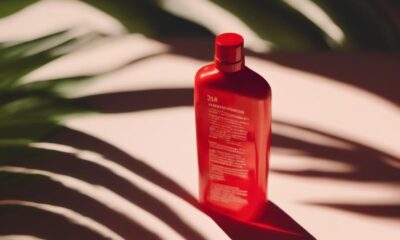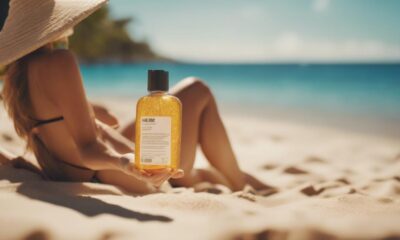Seasonal Skin Care
How to Protect Your Skin This Winter: Top Tips
Protect your skin this winter with essential tips that will keep it hydrated and healthy—discover what you need to know!

To protect your skin this winter, you need to moisturize daily with thick, fragrance-free creams right after bathing to lock in hydration. Limit cleansing to once daily and use gentle cleansers to avoid stripping your skin's natural oils. Keep showers short and lukewarm, then pat your skin dry and reapply moisturizer immediately. Use a humidifier indoors to combat dry air, and cover exposed skin with scarves when you go outside. Don't forget your sunscreen, even on cloudy days, to defend against UV rays. Stick around to discover more essential tips for keeping your skin healthy all winter long.
Key Takeaways
- Use a thick, fragrance-free moisturizer immediately after bathing to lock in moisture and protect your skin barrier.
- Maintain indoor humidity levels between 30% and 50% with a humidifier to combat dry winter air.
- Apply broad-spectrum sunscreen with SPF 30 or higher daily, even on cloudy days, to protect against UV rays.
- Dress in layers and use protective creams with ceramides to shield skin from cold and wind exposure.
Daily Moisturization Techniques
To keep your skin healthy this winter, it's important to adopt effective daily moisturization techniques that lock in moisture and protect against dryness.
Start by applying a thick moisturizer, preferably cream-based or petroleum jelly, directly to your skin right after bathing. This helps trap surface moisture and prevents dryness from the cold air. If you have sensitive skin, choose fragrance-free moisturizers to minimize irritation.
Incorporate skin care products that contain occlusive ingredients like glycerin and lanolin into your routine. These ingredients greatly improve hydration levels and bolster your skin's barrier function.
Remember to moisturize your hands frequently throughout the day, especially after washing, to combat winter dryness and irritation.
Additionally, consider adding hyaluronic acid to your daily moisturizing regimen. It enhances moisture retention and provides extra hydration benefits for both your face and body.
Effective Cleansing Routines

When it comes to keeping your skin healthy this winter, an effective cleansing routine is key.
You'll want to limit cleansing to just once a day and choose gentle, fragrance-free cleansers that won't irritate your skin.
Daily Cleansing Frequency
Cleansing your face just once daily helps preserve natural oils and keeps your skin hydrated throughout the winter. The harsh winter can strip moisture from your skin, making it vital to establish a balanced daily cleansing frequency. Over-cleansing can lead to dryness and irritation, so limit your routine to once a day.
While rinsing your trunk, arms, and legs daily is fine, avoid using soap on these areas to protect your skin barrier. When you do cleanse your face, opt for mild, fragrance-free cleansers. These gentle formulas are less likely to irritate your skin, especially if you have sensitive skin types.
After cleansing, it's important to apply a moisturizer shortly afterward. This locks in hydration and supports your skin barrier, keeping your complexion plump and healthy.
Gentle Cleanser Selection
Selecting a gentle cleanser is key for maintaining your skin's hydration during winter while effectively removing impurities. To keep your skin feeling soft and nourished, you should look for moisturizing gentle cleansers that won't strip away your skin's natural oils. Harsh ingredients can worsen dry skin and irritation, especially when temperatures drop.
Here are some tips for choosing the right gentle cleanser:
- Opt for cream-based or lotion cleansers: These often provide added moisture, making them ideal for normal to dry skin types.
- Avoid alcohol and harsh surfactants: These ingredients can exacerbate dryness and irritation, particularly if you have sensitive skin or eczema.
If you have eczema, look for cleansers that contain petrolatum, shea butter, or silicones. These ingredients can help enhance your skin barrier, providing extra protection during the harsh winter months.
Post-Cleansing Moisturization
Post-cleansing moisturization is essential for trapping hydration and keeping your skin supple during winter's harsh conditions. After you've cleansed your face, make sure to apply your moisturizer while your skin is still damp. This helps to effectively hydrate and lock in moisture, preventing dryness.
Choose gentle, fragrance-free cleansers that preserve your skin's natural barrier. Over-cleansing can lead to irritation and dryness, so stick to a routine that respects your skin's needs. If you opt for cream-based or moisturizing cleansers, you'll get added hydration that maintains skin integrity throughout winter.
If you use a toner, keep it hydrating and apply it within 30 seconds of cleansing. This timing maximizes hydration benefits. Follow up with a moisturizer rich in occlusive ingredients like petrolatum or hyaluronic acid. These ingredients enhance water retention and create a protective barrier against winter's drying effects.
Optimal Water Temperature

When showering or bathing, choose lukewarm water to protect your skin's natural oils and prevent dryness. Hot water might feel great at the moment, but it can strip away those essential oils, leading to increased moisture loss. To keep your skin healthy this winter, aim for the ideal water temperature that balances cleanliness and hydration.
Limit your shower to 5-10 minutes to minimize moisture loss from your skin.
After bathing, gently pat your skin dry with a towel instead of rubbing it, retaining more moisture on your skin's surface.
Immediately apply a thick moisturizer to lock in hydration and enhance your skin barrier function.
Managing Indoor Humidity

To keep your skin hydrated this winter, managing indoor humidity is key.
Using room humidifiers can help maintain the right moisture levels, while regular maintenance guarantees they work effectively.
Use Room Humidifiers
Room humidifiers are essential tools for combating the drying effects of winter air, helping you maintain skin hydration and overall comfort. During the winter months, indoor heating can greatly reduce humidity levels, leading to dry air that can cause skin dryness and irritation. By using room humidifiers, you can effectively prevent these issues and create a healthier living environment.
Here are a few benefits of using room humidifiers:
- Improved Skin Hydration: Adding moisture to the air helps keep your skin hydrated, reducing flakiness and tightness.
- Comfortable Breathing: A humidifier alleviates dry throat and respiratory discomfort, making it easier to breathe during colder months.
To maximize the benefits of room humidifiers, make sure to keep them clean and change the water regularly.
Regular Humidifier Maintenance
Maintaining your humidifier is key to guaranteeing it effectively manages indoor humidity and keeps your skin hydrated throughout the winter months.
Start by cleaning your humidifier regularly according to the manufacturer's guidelines. This helps prevent mold and bacteria growth, which can harm your air quality and skin health.
Make it a habit to change the water daily; fresh water promotes ideal humidity levels and guarantees that moisture is evenly distributed in your living space.
Aim for indoor humidity levels between 30% and 50% to combat the effects of cold air on your skin. Using a hygrometer can help you monitor these levels, allowing you to adjust your humidifier settings accordingly.
Additionally, consider using distilled or demineralized water in your humidifier. This reduces mineral buildup, enhancing the device's efficiency while protecting your skin from potential irritants.
Protecting Against Wind

Protecting your skin from harsh winter winds is essential to prevent dryness and irritation. Windburn can quickly wreak havoc on your skin, especially if you already have sensitive skin or conditions like eczema and rosacea.
To effectively shield yourself while maintaining skin hydration, consider these top tips:
- Cover Up: Use scarves or masks to minimize skin exposure to the elements. This simple step can greatly reduce irritation and dryness.
- Use Skin Protectants: Opt for products containing ceramides to create a barrier against moisture loss. These skin protectants are especially beneficial for combating dry winter skin.
Cold Weather Precautions

As you shield your skin from harsh winds, it's also important to take precautions against the extreme cold that can lead to serious skin issues. Cold weather can cause dryness, frostbite, and other skin disorders, so you need to be proactive in your skin care routine. Dress in layers to avoid prolonged exposure to frigid temperatures, and don't forget to cover any exposed skin.
| Tip | Action | Benefits |
|---|---|---|
| Dress in Layers | Wear thermal clothing | Insulates and retains body heat |
| Use Protective Creams | Apply ceramide-rich products | Shields skin from dry air and wind |
| Carry Lip Balm | Opt for petroleum-based balms | Prevents chapping and protects lips |
Recognize the symptoms of frostbite: pain, numbness, and discoloration. If you notice these signs, seek medical attention immediately. Remember, wind protection is essential; using the right products can help you effectively protect your skin from harsh winter conditions while keeping it hydrated and healthy.
Winter Sun Protection

Don't let the chilly weather fool you; winter sun protection is just as important as it is in summer, as UV rays can still harm your skin even on overcast days. Up to 80% of UV rays can reflect off snow, increasing your risk of skin damage.
So, applying broad-spectrum sunscreen with SPF 30 or higher is vital, even when it's cloudy.
Here are some key tips for winter sun protection:
- Reapply sunscreen every two hours, especially during outdoor activities.
- Consider moisturizers with SPF, which provide both hydration and sun protection.
Regular use of sunscreen not only shields you from harmful UV rays but also helps prevent premature aging and skin cancer.
When you plan your winter activities, make sure that protecting your skin from UV exposure is part of your routine. Your skin deserves the same level of care during winter as it does in summer, so don't skip that important layer of moisture and protection.
Alternatives to Tanning

If you're looking to maintain a sun-kissed glow during the winter months without the dangers of UV exposure, self-tanners offer a safe and effective option. These products typically contain dihydroxyacetone (DHA), which reacts with your skin's amino acids to create a temporary tan lasting about 5 to 7 days.
To enhance and prolong your tan, combine self-tanners with moisturizers. This not only combats winter dryness but also helps guarantee your tan looks its best. When choosing a self-tanner, opt for ones free from harsh chemicals and fragrances. This minimizes your risk of skin irritation, particularly if you have sensitive skin.
Before applying self-tanner, make certain to exfoliate your skin. This step is essential for achieving an even application and preventing patchiness, giving you a natural-looking result.
Importance of Vitamin D

During winter, the lack of sunlight makes it vital to pay attention to your vitamin D levels for maintaining healthy skin. Vitamin D supports your skin health by enhancing skin barrier function and reducing inflammation. This is especially important during the winter months when winter-related skin issues, like dryness and irritation, are common.
Consider these points to keep your vitamin D levels in check:
- Natural production decreases: With less sunlight, your body may struggle to produce enough vitamin D.
- Supplementation may be necessary: Adults typically need about 600 to 800 IU per day, and many might require supplements to meet these levels.
To guarantee you're getting enough vitamin D, consult a healthcare provider for testing and personalized supplement recommendations.
Taking these steps can notably improve your skin barrier function and overall skin health this winter, helping you combat those pesky winter-related skin issues effectively.
Frequently Asked Questions
How Can I Keep My Skin Good in Winter?
To keep your skin good in winter, use thick moisturizers right after bathing, limit cleansing, apply sunscreen, stay hydrated, and consider a humidifier to maintain moisture levels in your home. Your skin will thank you!
Does Vaseline Protect Skin From Cold?
You'd think winter's icy breath wouldn't care about your skin, but Vaseline's thick barrier actually locks in moisture. It's your secret weapon against the cold, preventing chapping and keeping your skin hydrated.
How Can I Protect My Face From Cold Wind?
To protect your face from cold wind, cover it with a scarf or mask. Apply a rich moisturizer and a petroleum-based lip balm. Limit your time outdoors, and seek shelter when it gets too harsh.
How Do You Fix Skin Barrier in Winter?
You might think your skin can handle winter's chill without help, but it can't. To fix your skin barrier, use thick moisturizers, limit cleansing, and keep humidity up. Consult a dermatologist if dryness persists.
Can Using Arctic Berry Help Protect My Skin in Winter?
Yes, using arctic berry skin protection can help protect your skin in winter. The powerful antioxidants found in arctic berries can help combat the harsh environmental elements, such as cold temperatures and dry air, that can lead to dry, flaky, and irritated skin. Keeping your skin nourished and protected is essential during the winter months.
Conclusion
This winter, your skin can either thrive or suffer, depending on how you care for it. By embracing daily moisturization and effective cleansing, you shield your skin from harsh conditions while nourishing it inside and out.
Just as winter can bring both beauty and danger, your choices can lead to a radiant glow or dryness. Prioritize sun protection and manage indoor humidity to find balance.
With these tips, you'll not only survive winter; you'll shine through it.
Seasonal Skin Care
Fall Skincare Essentials: What to Add to Your Routine
Discover the essential changes to your fall skincare routine that will leave your skin radiant and hydrated—what are the must-have products?

To upgrade your fall skincare routine, start by switching to a richer moisturizer that hydrates and protects against dryness. Incorporate hydrating serums with hyaluronic acid to lock in moisture and improve texture. Revamp your cleansing routine with gentle, hydrating cleansers that won't strip your skin. Don't forget to use a nourishing eye cream to combat dryness in that delicate area. Embrace gentle exfoliation once or twice a week to keep your skin glowing. And always apply broad-spectrum sunscreen, even in cooler weather. Ready to discover more tips for radiant skin this fall?
Key Takeaways
- Upgrade to a richer moisturizer with ingredients like ceramides to combat dryness and strengthen the skin barrier during colder months.
- Incorporate hydrating serums containing hyaluronic acid and niacinamide to boost moisture and improve skin texture.
- Use a gentle cleansing routine with hydrating balms and pH-balancing toners to prevent irritation and maintain hydration.
- Apply nourishing eye creams with vitamin C and peptides to combat dryness and fine lines around the eye area.
Upgrade to a Richer Moisturizer
As the temperature drops, you need to upgrade to a richer moisturizer to keep your skin hydrated and healthy. Lightweight lotions just won't cut it anymore; they can't provide the necessary hydration your skin craves in colder weather.
Opt for a thicker moisturizer that focuses on strengthening your skin barrier, which is essential for retaining moisture and preventing dryness. Look for ingredients like murumuru butter and cica extract in your richer moisturizer. These components not only enhance hydration but also support skin healing, helping to repair any damage caused by the harsh elements.
A high-quality moisturizer can be your first line of defense against common fall skin issues such as flaking, redness, and overall irritation. If you have sensitive skin, steer clear of fragrances and oils that can trigger skin irritation.
Instead, choose a fragrance-free, oil-free option that delivers the hydration you need without adding to your skin's woes. By upgrading to a richer moisturizer, you'll keep your skin soft, supple, and protected throughout the chilly months ahead.
Revamp Your Cleansing Routine

How can you revamp your cleansing routine to keep your skin hydrated and healthy as the weather cools down?
Start by shifting to a hydrating cleansing balm, like the probiotics + moringa oil makeupmelt cleansing balm. This product effectively removes makeup while providing intense hydration, perfect for fall.
Incorporate key ingredients such as cactus extract and sunflower seed wax to enhance moisture retention and soothe the skin during this season. A gentle and hydrating cleansing routine is essential in the fall, as colder weather and indoor heating can lead to dryness and irritation.
After using your cleansing balm, follow up with a pH-balancing and moisturizing toner, like milkdew, to maintain hydration and prepare your skin for subsequent products.
Regularly assess your cleansing products to confirm they align with your skin's changing needs during the shift from summer to fall.
Lock in Moisture With Serums

To keep your skin hydrated this fall, incorporating serums with key ingredients like hyaluronic acid and niacinamide is a must.
These powerful components not only attract moisture but also improve your skin's texture and resilience.
Plus, knowing the right application techniques can maximize their benefits, ensuring your skin stays healthy and glowing all season long.
Key Hydrating Ingredients
Incorporating key hydrating ingredients into your serum can lock in moisture and keep your skin radiant throughout the fall season. The right combination of ingredients not only boosts hydration and protection but also enhances your skin's natural barrier, maintaining ideal moisture levels.
Here are three must-have ingredients to look for in your serums:
- Triple Hyaluronic Acid: This powerhouse can hold up to 1,000 times its weight in water, ensuring your skin stays deeply hydrated.
- Niacinamide: Known for its anti-aging benefits, it improves collagen production while preventing moisture loss, reducing the appearance of fine lines.
- Ceramides: Essential for maintaining your skin's natural barrier, ceramides help lock in hydration and prevent dryness as temperatures drop.
Application Techniques Explained
Applying serums correctly can make a significant difference in locking in moisture and enhancing your skin's hydration.
Start by using just a few drops of your chosen serum, ideally one containing hyaluronic acid, which can hold up to 1,000 times its weight in water. Gently press the serum into your skin with your fingertips; this application technique boosts absorption and helps the active ingredients penetrate deeper.
For best results, apply the serum on slightly damp skin after cleansing. This extra moisture allows the serum to work more effectively, ensuring you maximize hydration.
After the serum, follow up with a richer moisturizer to seal in that hydration, preventing transepidermal water loss throughout the day.
Embrace Gentle Exfoliation

Gentle exfoliation is essential for maintaining a radiant complexion during fall, as it helps remove dead skin cells and enhances your skin's texture without causing irritation. As temperatures drop and humidity decreases, your skin needs that little boost to keep its glow.
To embrace gentle exfoliation, consider these key practices:
- Opt for AHAs and BHAs: These gentle acids improve product absorption and promote cell turnover, ensuring your skin stays fresh and rejuvenated.
- Limit Exfoliation to 1-2 Times a Week: Over-exfoliating can compromise your skin's natural barrier, leading to increased dryness or irritation. Stick to this frequency for best results.
- Choose the Right Products: Look for products like glowoasis probiotics + papaya enzyme exfoliating powder, which uses papaya enzymes and Jeju volcanic ash to enhance your skin's texture.
Say No to Hot Water

Hot water may feel soothing, but it can actually strip your skin of essential oils, leading to dryness and irritation as the temperatures drop. Instead of reaching for that steaming hot shower, consider using lukewarm or cool water for your cleansing routine. This simple switch helps maintain your skin's moisture barrier, which is vital for keeping your skin healthy and hydrated throughout fall.
Different skin types react uniquely to temperature changes. For instance, if you have sensitive skin or conditions like eczema, hot water can exacerbate irritation and redness. By opting for moderate water temperatures, you can prevent the flakiness often associated with colder weather.
Incorporating lukewarm water into your cleansing routine not only protects your skin but also promotes better circulation, enhancing your overall comfort during the process. Remember, your skin is delicate, and maintaining its natural oils is important for overall health.
Calm Redness and Irritation

To effectively calm redness and irritation this fall, focus on incorporating anti-inflammatory ingredients into your skincare routine. These key components will help soothe your sensitive skin and restore balance.
Here are three essential steps to remember:
- Gentle Cleansing: Start with a gentle cleanser like the probiotics + moringa oil makeupmelt cleansing balm. It removes impurities without stripping your skin, preventing further redness.
- Calming Toner: Use a calming toner, such as the probiotics + murumuru ultra calming toner. Its formulation with rosemary leaf water works wonders for soothing irritated skin and reducing discomfort.
- Rich Moisturizer: Follow up with a rich moisturizer like the probiotics + murumuru hydra surge moisturizer. This will hydrate your skin while delivering essential nutrients to calm redness and irritation.
For added relief, consider a calming serum containing niacinamide, known for its ability to improve overall skin tone and reduce redness.
Nourish the Eye Area

Nourishing the eye area is crucial for preventing fine lines and maintaining a youthful appearance, especially as the drier fall weather sets in. The skin around your eyes is particularly susceptible to dehydration, making a nourishing eye cream essential for hydration. Look for products infused with vitamin C to help brighten the skin and reduce dark circles, while also enhancing overall radiance.
During fall's drier weather, your eye area needs extra care. Incorporating richer, emollient eye products guarantees your skin stays moisturized. Probiotics combined with triple peptides can provide cooling and de-puffing effects, enhancing hydration and promoting a smoother texture. These ingredients also stimulate collagen production, helping to firm the delicate skin over time.
Regularly applying a nourishing eye cream not only combats dryness but also helps maintain elasticity, so you can enjoy a more youthful look. Choose formulas that include xylitol for added moisture and a revitalizing feel.
Hydrate Inside and Out

To keep your skin looking its best this fall, you need to focus on hydration from the inside out.
Drinking plenty of water and incorporating hydrating products like serums can make a real difference.
Let's explore how these strategies can help you maintain that healthy glow.
Internal Hydration Importance
Hydration from within is crucial for keeping your skin elastic and preventing dryness, especially as colder months approach and humidity drops. To maintain ideal skin moisture levels, focus on these key aspects of internal hydration:
- Adequate Water Intake: Aim for at least eight glasses of water daily. This supports skin elasticity, flushes out toxins, and enhances your skin's radiance.
- Hydrating Foods: Incorporate foods like cucumbers and watermelon into your diet. They're packed with water and essential vitamins that greatly boost skin health and moisture levels.
- Omega-3 Fatty Acids: Consider adding omega-3 supplements to your routine. These healthy fats promote a hydrated and youthful complexion while reducing inflammation.
Don't underestimate the power of herbal teas either; they provide hydration and antioxidants that combat free radicals.
Remember, internal hydration is just as crucial as topical products. By nourishing your body from within, you'll set the foundation for glowing, healthy skin throughout the fall and winter months.
Prioritize your internal hydration, and watch your skin thrive!
Hydrating Product Recommendations
Finding the right hydrating products can make all the difference in keeping your skin plump and radiant during the fall months. Start by incorporating hydrating serums that contain hyaluronic acid; they attract moisture and boost hydration, which is essential for combating dry skin.
Next, choose rich moisturizers, like probiotics + murumuru hydra surge moisturizer, that feature ceramides and vegan probiotics. These ingredients help lock in moisture and support your skin barrier, ensuring your skin stays protected against the elements.
Don't forget about hydration from the inside out! Drink plenty of water and include hydrating foods like cucumbers and watermelon in your diet to support your skin's moisture levels.
Additionally, consider using a humidifier indoors to maintain moisture in the air, which can help prevent skin dryness during colder months.
Consistent Sunscreen Application

Because UVA and UVB rays can still harm your skin in the fall, consistent sunscreen application is essential for maintaining healthy skin year-round. It's not just for summer; up to 80% of UV rays can penetrate through clouds, putting your skin at risk.
To protect yourself, focus on these key points:
- Opt for broad-spectrum sunscreen: Choose a product with at least SPF 30 protection. This shields you from both UVA rays and UVB rays, vital for preventing skin cancer and premature aging.
- Don't skip daily reapplication: Apply sunscreen every two hours when you're outdoors, especially during activities that increase sun exposure. This keeps your skin safeguarded throughout the day.
- Make it a part of your routine: Incorporate SPF into your daily skincare with moisturizers or BB creams. This simple adjustment can greatly improve your skin tone and texture over time, while also protecting against long-term damage like discoloration and wrinkles.
Frequently Asked Questions
How to Take Care of Your Skin in the Fall?
To take care of your skin in the fall, switch to a richer moisturizer, use a hydrating cleansing balm, apply sunscreen daily, gently exfoliate weekly, and stay hydrated with water and humidifiers.
What Should I Add to My Skincare Routine?
To enhance your skincare routine, consider adding a richer moisturizer, a hydrating cleansing balm, a glowshot serum, a gentle exfoliator, and a nourishing eye cream. These products will help keep your skin hydrated and healthy.
What Are the Essentials of a Good Skincare Routine?
A good skincare routine includes a gentle cleanser, regular exfoliation, proper hydration, and daily sunscreen. Tailor your products to your skin type for best results, ensuring your skin stays healthy and protected year-round.
What Are the 7 Most Important Products Steps in a Skincare Routine?
You think slathering on cream is enough? Think again! A solid routine includes cleansing, toning, exfoliating, treating, moisturizing, protecting, and nourishing. Each step builds on the last, transforming your skin into a radiant masterpiece.
Can Summer Skincare Essentials Also Be Used in the Fall?
Transitioning from summer to fall doesn’t necessarily mean you have to ditch your summer skincare essentials: essential products altogether. While you may need to adjust your routine to accommodate for changing weather conditions, some items like sunscreen and lightweight moisturizers can still be beneficial during the fall months.
Conclusion
As the leaves change and cooler air settles in, it's the perfect time to refresh your skincare routine.
By upgrading to a richer moisturizer and embracing gentle exfoliation, you'll keep your skin glowing and hydrated.
Don't forget to nourish the delicate eye area and lock in moisture with serums.
With consistent sunscreen application, you'll protect your skin from unexpected sun exposure.
So, while you enjoy the beauty of fall, give your skin the care it deserves!
Seasonal Skin Care
Spring Cleaning for Your Skin: Detox Tips
Jumpstart your skincare routine with essential detox tips that will rejuvenate your skin—discover what you need to know for a fresh start!

Spring cleaning for your skin is all about reassessing your products and routines. Start by checking expiration dates and removing any items that irritate your skin. Incorporate hydrating ingredients like hyaluronic acid and vitamin C to brighten your complexion. Simplify your routine by opting for lighter products that suit seasonal needs. Don't forget to declutter: use the "one in, one out" rule, and donate anything unopened. Give yourself a fresh start with gentle cleansers and nourishing serums. Want to discover more tips for a rejuvenated skincare routine? There's plenty more to explore on this topic.
Key Takeaways
- Check and discard expired skincare products to enhance effectiveness and prevent irritation.
- Simplify your routine by incorporating seasonal ingredients and prioritizing sun protection with SPF.
- Organize products by category, using bins for easier access and a clutter-free space.
- Donate unused or unopened products to promote sustainability and help those in need.
Importance of Spring Skincare Detox
As spring arrives, it's the perfect time to detox your skincare routine and breathe new life into your complexion after the harsh winter months. The shift into warmer weather signals a fresh start, making it essential to reassess your skincare products.
Start your Spring Clean by clearing out expired items that may no longer deliver the good stuff your skin needs. Winter can leave behind dead skin and dullness, so it's vital to cleanse your skin thoroughly.
Focus on products that emphasize hydration, like those containing hyaluronic acid and amino acids, which can help rejuvenate your complexion. Incorporating Vitamin C into your routine can also brighten your skin and enhance its radiance.
A focused detox not only promotes a healthier skincare regimen but also aligns your products with your skin's current needs. By shedding the remnants of winter and embracing lightweight, effective formulas, you'll set yourself up for glowing skin this spring.
Assessing Current Products

Start by examining your current skincare and makeup products to determine what truly works for your skin and what needs to be tossed.
Begin with expiration dates; many products have a shelf life of 3-12 months, and using expired items can compromise both effectiveness and safety.
Next, identify any products that cause skin irritation or allergic reactions. These are the culprits that disrupt your skincare routine and could lead to further issues.
Evaluate how well your current skincare items perform. Do they suit your skin type? If not, it might be time to find alternatives that better meet your needs.
While you're at it, check for duplicates or unused products in your collection. Streamlining your beauty regimen can make a significant difference in your daily routine and help reduce clutter.
Decluttering Techniques

To keep your skincare collection manageable, try the 'one in, one out' rule—when you buy a new product, let go of an old one.
Organizing your items by category can also help you quickly find what you need without the clutter.
Plus, consider donating any unopened products you won't use; it clears space and helps those in need.
One In, One Out
Embracing the 'one in, one out' rule can transform your skincare routine by keeping your collection curated and manageable. Each time you buy a new product, make it a point to let go of one item. This not only helps reduce clutter but also encourages you to think critically about whether the new product suits your skin type and meets your specific needs.
Regularly evaluating your collection through this technique allows you to identify expired products, which often have a shelf life of just 3-12 months after opening. This practice fosters a habit of assessing product effectiveness, ensuring that what you use is beneficial for your skin health.
As you implement the 'one in, one out' approach, your skincare space becomes more organized. You'll find it easier to locate your favorite and most effective products, enhancing your overall routine.
Organize by Category
Organizing your skincare and makeup products by category streamlines your routine and makes it easier to find what you need. Start by grouping your items into categories such as skincare, makeup, and tools. This organization increases accessibility and simplifies the decluttering process, allowing you to see what you have at a glance.
Implement the 'one in, one out' rule to manage product intake effectively. When you buy a new skincare product, let it replace an old or unused item. Regularly assess your products and dispose of those that are past their expiration dates, as many skincare items have a shelf life of 3-12 months.
Utilize storage solutions like bins or drawer organizers to maintain order and prevent overcrowding in your beauty space. By keeping similar items together, you'll not only save time but also make your skincare routine more enjoyable.
Donate Unused Products
Donating unused beauty products not only frees up space but also helps those in need and promotes sustainability. Start by separating your items into three categories: keep, toss, and donate. This will streamline the decluttering process effectively.
Look for unopened products that you no longer plan to use; local charities or Buy Nothing groups are great places to donate these items.
When you donate, clearly communicate the condition and usage of the products. This transparency helps recipients make informed choices about what they're taking home. Remember, many people might appreciate a high-quality moisturizer or a luxurious face mask that you've never used.
Regularly revisiting your collection not only maintains an organized space but also encourages sustainable practices in your beauty routine. By donating, you're reducing waste and contributing to environmental sustainability, which is essential for the health of our planet.
Plus, you're giving your skin a break from unnecessary clutter, allowing you to focus on the products that truly work for you. So, gather those unused products and make a difference today—your skin and the community will thank you!
Updating Skincare Routine

As the seasons change, it's vital to refresh your skincare routine to meet your skin's evolving needs. Spring brings warmer weather and increased outdoor activities, making it the perfect time to reassess what you're using.
Start by incorporating seasonal ingredients like lightweight moisturizers and serums rich in hyaluronic acid or glycerin. These will help maintain hydration without weighing your skin down.
Don't forget about sun protection! With more time spent outdoors, a broad-spectrum SPF becomes important to guard against harmful UV rays.
Simplify your routine by focusing on a few key products to prevent overloading your skin, which can lead to irritation.
This is also a great opportunity to experiment with newer formulations. Try out tinted moisturizers or brightening serums to refresh your look and enhance your skin's radiance for the season.
Regularly assess your products' effectiveness, discarding any that are expired or cause irritation.
Reassessing Makeup Choices

As spring arrives, it's the perfect time to reassess your makeup choices.
You might want to switch to lighter foundations for a fresh look while ensuring your brushes and tools are clean to maintain healthy skin.
Prioritizing these changes won't only enhance your beauty routine but also keep your skin happy.
Lighter Foundations Preference
Switching to lighter foundations or tinted moisturizers this spring can refresh your look and let your skin breathe. This is especially beneficial if you have oily or combination skin. Lightweight formulations often include hydrating ingredients like hyaluronic acid, ensuring your skin stays moisturized without the heaviness of traditional foundations.
Spring is the perfect time to experiment with brighter, pastel shades that mirror the season's vibrancy. Plus, consider multi-use products like tinted moisturizers with SPF, which simplify your routine while providing essential sun protection.
To help you choose the right product, here's a quick comparison:
| Product Type | Benefits |
|---|---|
| Lightweight Foundation | Enhances complexion, allows skin to breathe |
| Tinted Moisturizer | Hydrates while offering light coverage and SPF |
| Multi-use Products | Streamlines routine and protects against sun damage |
Lastly, don't forget to regularly assess your makeup stash. Replace any expired foundations, especially those meant for the eyes, to maintain skin health and prevent irritation. Embrace the season with a fresh, light approach to your makeup!
Cleanliness of Makeup Tools
Keeping your makeup tools clean is essential to maintaining healthy skin and preventing breakouts. Regularly cleaning your makeup brushes at least once a week helps eliminate bacteria buildup that can cause irritation and acne. It's a simple step that can notably impact your skin's health.
Next, take a look at your makeup collection. Replace any expired products, especially eye items like mascara and eyeliner, which usually last only three to six months. This guarantees you're not applying potentially harmful substances to your skin.
While you're at it, evaluate your current makeup for duplicates or rarely used items. Streamlining your collection can reduce clutter and make your routine more efficient. Consider switching to lighter foundations or tinted moisturizers as the weather warms up; these options promote a fresh, breathable look for spring.
Lastly, think about incorporating multi-use products, like lip and cheek tints, into your routine. They save space and simplify application while helping you achieve a radiant appearance. By focusing on the cleanliness of your tools and the quality of your makeup, you can enhance your skin's health this spring.
Sustainable Practices

Embracing sustainable practices in your skincare routine not only benefits the planet but also enhances your beauty regimen. By making mindful choices, you can create a positive impact while caring for your skin.
Here are four effective ways to infuse sustainability into your beauty routine:
- Choose sustainable packaging: Support brands that use biodegradable materials or offer refillable options to considerably cut down on waste.
- Recycle empty containers: Follow local guidelines to recycle your beauty products. Many brands even have take-back programs that promote responsible disposal.
- Opt for cruelty-free and vegan products: These choices not only align with ethical consumption but also contribute to a cleaner and greener beauty routine.
- Incorporate multi-use products: Use items like lip and cheek stains to minimize clutter and reduce the number of products you buy.
Deep Cleansing Methods

How well do you cleanse your skin? Deep cleansing methods are essential for maintaining a healthy complexion and preventing breakouts. To maximize your cleansing routine, aim for a gentle yet effective approach. Here's a quick guide to help you navigate the best methods:
| Method | Key Ingredients | Frequency |
|---|---|---|
| Oil Cleansing | Jojoba oil, sweet almond oil | Daily |
| Gentle Exfoliation | Salicylic acid, clay masks | Weekly |
| Hydrating Cleanser | Ceramides, hyaluronic acid | Twice daily |
| Mild Foaming Cleanser | Glycerin, soothing botanicals | Twice daily |
| Deep Cleansing Mask | Charcoal, kaolin clay | Weekly |
For effective cleansing, spend at least 60 seconds cleansing your face twice daily. Choose products that support your skin barrier while effectively removing impurities. Remember to assess your skin type regularly; harsh cleansers can irritate and compromise your skin's health. By incorporating these deep cleansing methods, you'll achieve a fresh and radiant complexion in no time!
Nourishing Your Skin

Nourishing your skin is essential for maintaining its health and radiance, especially during the spring months. To keep your skin glowing, consider these effective tips:
- Hydrating Serums: Use serums packed with hyaluronic acid and glycerin. These ingredients help maintain moisture balance and improve skin elasticity, giving you a plump appearance.
- Oil Cleansing: Embrace oil cleansing to remove impurities without stripping natural oils. Jojoba oil, sweet almond oil, and fractionated coconut oil are excellent choices for keeping your skin clean and nourished.
- Nourishing Facial Oils: Incorporate nourishing facial oils like sweet almond oil into your routine. They enhance hydration and repair your skin barrier, leading to a radiant complexion.
- Antioxidant-Rich Products: Look for serums containing niacinamide and vitamin C. These antioxidants protect your skin from environmental stressors while improving tone and brightness.
Additionally, don't forget to maintain a balanced diet rich in omega-3 fatty acids and hydrate with water and fruits. Supporting your skin from within will contribute to a clearer, more vibrant appearance.
Frequently Asked Questions
What Is Spring Cleaning Ritual?
A spring cleaning ritual involves revitalizing your space by decluttering and organizing. You assess what you need, discard what you don't, and create a more inviting environment that encourages productivity and peace of mind.
Is Spring Cleaning Good for You?
Studies show that decluttering your space can reduce stress by 40%. So yes, spring cleaning is good for you! It refreshes your environment, boosts productivity, and enhances your mood, making you feel more energized and focused.
What Order Do You Cleanse Your Skin?
To cleanse your skin, start with an oil-based cleanser to remove makeup, then follow with a water-based cleanser. Exfoliate 2-3 times weekly, and finish with a hydrating toner or serum for ideal results.
How Can I Make My Skin Feel Clean?
To put your best foot forward, start by cleansing twice daily for at least 60 seconds. Incorporate gentle exfoliants and stay hydrated—this'll keep your skin feeling clean, fresh, and radiant all day long.
Can Detox Tips Help Cleanse My Pores as Well?
Spring cleaning pores with flower may not effectively cleanse your pores. Detox tips, however, can help in purifying and unclogging the skin to achieve a clearer complexion. Regular exfoliation, proper hydration, and a healthy diet are essential for achieving clean and refreshed pores.
Conclusion
To wrap up your spring skincare detox, remember to evaluate your products, refresh your routine, and embrace sustainability.
By decluttering your shelves, nourishing your skin, and reassessing your makeup, you're not just cleaning up; you're revitalizing your glow.
Prioritize what works for you, simplify your regimen, and celebrate the fresh start.
This season, let your skin breathe, let your confidence shine, and let your beauty reflect the vibrant energy of spring!
Seasonal Skin Care
How to Prevent Winter Skin Damage: Top Tips
Improve your winter skin health with essential tips and tricks that will keep dryness and damage at bay—discover what you need to know!

To prevent winter skin damage, focus on hydration and protection. Use a thick moisturizer with ceramides right after showering to lock in moisture. Simplify your skincare routine by opting for gentle cleansers and limit exfoliation to once a week. Don't forget to apply sunscreen daily, even on cloudier days, as UV rays can still harm your skin. Stay hydrated by drinking plenty of water and using a humidifier to maintain indoor moisture levels. Protect your skin from harsh winds by covering up with warm scarves. Discover more essential tips and tricks to keep your skin healthy this winter.
Key Takeaways
- Daily moisturization with thick creams containing ceramides and glycerin is essential to combat winter dryness.
- Use humidifiers to maintain indoor humidity levels between 40-60% for optimal skin hydration.
- Protect your skin from harsh winds by covering your face with scarves and using thick moisturizers.
- Apply broad-spectrum sunscreen with at least SPF 30 daily, even on cloudy winter days.
Understand Dry Skin Symptoms
Understanding the symptoms of dry skin is essential, especially during winter when harsh elements can exacerbate the condition. You need to recognize these symptoms early to take protective measures against further irritation.
Common signs include flakiness, itchiness, and a rough texture. During the winter months, your skin can become particularly susceptible to moisture loss due to cold air and indoor heating.
You might notice redness or scaling on areas like your face, hands, and feet. If you experience a tight feeling after bathing, that's a clear indicator of moisture loss. Severe cases can lead to deep cracks or raw patches, increasing the risk of infections if bacteria enter these fissures.
Pay attention to how your skin feels; ashy or gray skin can signal advanced dryness. Being proactive is key. By understanding these symptoms, you can implement protective measures to combat dry skin effectively.
If you notice persistent dryness or worsening symptoms, it might indicate an underlying skin condition that requires medical advice. Don't wait; addressing these signs early can help you maintain healthier skin throughout the winter.
Importance of Daily Moisturization

Daily moisturization is essential to keep your skin hydrated and protected from the harsh winter elements. During winter, the humidity drops, making it vital to use a good moisturizer daily. A thick moisturizer, particularly those containing ceramides and glycerin, can effectively lock in hydration and repair your skin barrier.
Applying your moisturizer right after bathing, while your skin is still damp, enhances moisture retention and makes it more effective. Regular daily moisturization helps prevent dry skin, which can lead to complications like eczema flare-ups and skin infections.
To maximize your skin's health, don't forget to moisturize your hands frequently throughout the day, especially after washing them. Soap and water can strip your skin of moisture, so reapplying a moisturizer helps combat these drying effects.
Adjust Your Skin Care Routine

As winter sets in, you need to adjust your skin care routine to keep your skin healthy and hydrated.
Simplifying your regimen and choosing gentle products can make a big difference in preventing dryness and irritation.
Focus on using cream-based moisturizers and mild cleansers to help maintain your skin's moisture barrier during these colder months.
Simplify Your Routine
During winter, simplifying your skincare routine to focus on essential products like a moisturizer and sunscreen can greatly protect your skin from damage. By limiting the number of products you use, you can maintain a healthy moisture barrier and reduce the risk of irritating sensitive skin.
Here are four tips to simplify your routine:
- Choose a Quality Moisturizer: Opt for a fragrance-free and alcohol-free moisturizer that hydrates effectively and soothes dry skin.
- Limit Exfoliation: Stick to exfoliation once a week, using gentle methods to avoid damaging your already compromised skin barrier.
- Moisturize Immediately: Establish a routine where you apply your moisturizer right after cleansing or bathing to lock in hydration.
- Incorporate Sunscreen Daily: Protect your skin from UV damage by applying a broad-spectrum sunscreen, even on cloudy days.
Choose Gentle Products
Choosing gentle products is essential for adjusting your skincare routine in winter to prevent irritation and maintain hydration. Start by opting for a gentle cleanser that's fragrance-free. This helps to avoid stripping your skin of its natural oils, which can lead to increased dryness.
Limit the use of exfoliating products; if you need to exfoliate, choose gentle chemical exfoliants instead of harsh scrubs to protect your skin barrier. During the colder months, your skin can be more sensitive, so scaling back on harsh active ingredients like retinoids and AHAs is wise.
Incorporate thicker, emollient-rich moisturizers into your routine. Look for those containing ingredients like ceramides and glycerin, as these can help repair and maintain your skin's moisture barrier.
Applying all skincare products, including your moisturizer, immediately after bathing is vital. This locks in moisture and enhances absorption, keeping your skin hydrated throughout the day.
Stay Hydrated Internally

To keep your skin healthy this winter, you need to stay hydrated internally.
Make sure you're drinking plenty of water, eating hydrating foods, and avoiding beverages that can dehydrate you.
Prioritizing these habits will help maintain your skin's moisture and elasticity all season long.
Drink Plenty of Water
Drinking plenty of water is essential for keeping your skin hydrated and healthy throughout the winter months. When the cold weather hits, your skin moisture barrier can weaken, leading to dry, irritated skin. By ensuring you stay well-hydrated, you can effectively combat dry skin and improve overall skin appearance.
Here are some tips to help you drink enough water:
- Set a daily goal: Aim for at least 8 glasses (about 2 liters) of water daily to maintain ideal hydration levels.
- Incorporate herbal teas: Enjoy warm herbal teas, which not only hydrate but also offer additional nutrients for your skin.
- Limit caffeine and alcohol: These beverages can lead to dehydration, so keep them in moderation to protect your skin.
- Use reminders: Set reminders on your phone to drink water throughout the day, ensuring you don't forget to stay hydrated.
Consume Hydrating Foods
Including hydrating foods in your diet can greatly boost your skin's moisture levels and help prevent winter dryness. When you consume foods rich in omega-3 fatty acids, like fatty fish, flaxseeds, and walnuts, you'll see a higher level of hydration in your skin. These foods work to reduce dryness and enhance moisture retention.
Incorporating antioxidant-rich fruits and vegetables, such as berries and leafy greens, will also support your skin health. They combat oxidative stress, which can worsen skin conditions during cold weather.
Additionally, focus on foods with high water content, like cucumbers, oranges, and soups. These hydrating foods not only taste great but also contribute to your overall hydration levels.
Avoid Dehydrating Beverages
Maintaining hydration isn't just about consuming hydrating foods; avoiding dehydrating beverages is equally important for keeping your skin healthy during winter. As the air gets drier, your skin can suffer if you're not careful with your fluid consumption.
Here are some tips to help you stay hydrated internally:
- Drink Plenty of Water: Aim for at least eight glasses a day to maintain skin hydration levels.
- Limit Caffeinated Drinks: Be mindful of coffee and sodas, as caffeine can lead to increased fluid loss.
- Avoid Alcohol: Drinking alcohol can further exacerbate dehydration, so keep it to a minimum.
- Choose Herbal Teas: Opt for herbal teas instead of traditional teas; they can contribute to your daily fluid intake while offering additional nutrients beneficial for skin health.
Use Humidifiers Effectively

Using a humidifier effectively can dramatically improve your skin's hydration and comfort during the dry winter months. Humidifiers are fundamental for combating dry indoor air, helping to maintain moisture levels around 40-60%. This ideal humidity is essential for enhancing skin health and preventing dryness.
To maximize the benefits, place a humidifier in your bedroom while you sleep. This can considerably reduce symptoms of dry skin and enhance overall skin hydration overnight. Additionally, consider using portable humidifiers in high-traffic areas or rooms where you spend the most time. This strategic placement helps maintain moisture levels throughout your living space.
Regularly cleaning and maintaining your humidifier is crucial. It prevents mold growth and guarantees efficient moisture output, which directly affects your skin's hydration.
Studies show that increased humidity from humidifiers can improve skin hydration, reducing the incidence of dryness, flakiness, and irritation associated with winter weather.
Protect Against Harsh Winds

Harsh winds can strip your skin of moisture, so it's essential to take protective measures when heading outdoors during winter. Wind exposure can worsen moisture loss, leading to dry, irritated skin.
Here are some effective strategies for protecting your skin:
- Cover Up: Use scarves or masks to shield your face from harsh winter winds. This simple step can greatly reduce irritation and moisture loss.
- Moisturize: Apply a thick moisturizer or skin protectant with ceramides before going outside. This creates a barrier against windburn and keeps your skin hydrated.
- Lip Care: Don't forget your lips! Use petroleum-based lip balms to protect against cracking and chapping caused by cold air and wind exposure.
- Layer Clothing: Wear soft, non-irritating fabrics to minimize skin exposure to the cold. Avoid rough materials like wool, which can aggravate sensitive skin.
Apply Sunscreen Year-Round

When it comes to winter skin care, don't underestimate UV exposure risks.
Applying sunscreen daily is essential, even on cloudy days, as those rays can still reach your skin.
Make it a habit to protect yourself and keep your skin healthy all year round.
UV Exposure Risks
Even in winter, UV rays can damage your skin, so applying sunscreen year-round is a must. Many people believe that skin protection is only necessary in the summer, but winter sun exposure can be just as harmful. Up to 80% of UV radiation can penetrate clouds, and snow reflects up to 80% of these rays, increasing your exposure when you're outdoors.
To protect your skin effectively, keep these tips in mind:
- Choose Broad-Spectrum Sunscreen: Use a broad-spectrum sunscreen that protects against both UVA and UVB rays.
- Opt for SPF 30 or Higher: Dermatologists recommend a minimum SPF of 30 for daily protection, regardless of the season.
- Reapply Regularly: Make sure to reapply sunscreen every two hours, especially during prolonged outdoor exposure.
- Don't Skip on Cloudy Days: Even on cloudy days, UV rays can still reach your skin, so don't skip the sunscreen.
Daily Application Importance
Why risk skin damage this winter when applying sunscreen daily can offer essential protection against harmful UV rays?
Even in cold weather, up to 80% of UV rays can penetrate clouds and reflect off snow, increasing your exposure risk. Daily application of broad-spectrum sunscreen with at least SPF 30 is essential to shield your skin from these damaging rays.
During winter, dry air can exacerbate skin conditions and compromise your skin's moisture barrier. By incorporating sunscreen into your morning routine, you not only protect against UV rays but also help maintain that critical moisture barrier. This is especially important when the elements are harsh and can leave your skin feeling parched and irritated.
Moreover, regular use of sunscreen can prevent signs of premature aging, like wrinkles and sunspots, which can still develop regardless of the temperature.
Don't forget to reapply every two hours when you're outdoors, especially if you're engaging in winter sports, as these activities can further increase UV exposure.
Make sunscreen a non-negotiable part of your winter skincare regimen to keep your skin healthy and protected all season long.
Control Water Temperature

To protect your skin during winter, control the water temperature by opting for lukewarm water between 96-99 degrees Fahrenheit. Hot showers may feel great, but they can strip your skin of its natural oils, leading to dryness and irritation.
Here are some tips to keep your skin hydrated and maintain its moisture barrier:
- Limit your shower duration: Aim for 5-10 minutes to reduce moisture loss and avoid redness that indicates the water is too hot.
- Avoid long, hot baths: These can exacerbate dryness and increase skin irritation, so stick to shorter, cooler baths.
- Use gentle cleansers: Choose non-irritating products specifically formulated for dry, sensitive skin to retain your skin's moisture barrier.
- Moisturize immediately: Right after showering or bathing, apply a moisturizer to lock in moisture and counteract the drying effects of water.
Be Cautious With Exfoliation

Exfoliation can be a double-edged sword during winter, as it helps remove dead skin but can also lead to dryness and irritation if overdone. To maintain your skin's moisture barrier, it's essential to be cautious with your exfoliation routine. Limiting exfoliation to once a week can help prevent excessive dryness, especially for sensitive winter skin.
Consider the type of exfoliant you use. Gentle chemical exfoliants, such as lactic or glycolic acid, are preferable to harsh physical scrubs. They effectively remove dead skin cells without damaging your skin. Always observe how your skin responds post-exfoliation; if you notice redness or irritation, it might be time to reduce frequency or switch to milder products.
Incorporating moisturizing ingredients into your exfoliating products can also boost hydration. Here's a quick guide for your reference:
| Exfoliation Type | Benefits | Recommendations |
|---|---|---|
| Chemical Exfoliants | Gentle on skin, effective removal | Lactic Acid, Glycolic Acid |
| Physical Scrubs | Immediate smoothing | Avoid harsh scrubs |
| Moisturizing Ingredients | Retain moisture | Hyaluronic Acid, Glycerin |
Consult a Dermatologist When Needed

Consulting a dermatologist can be crucial if you're dealing with persistent dry skin, as they can diagnose underlying issues and recommend effective treatments. Don't hesitate to seek professional advice when your skin doesn't improve with over-the-counter remedies.
Here's when you should consider a visit:
- Persistent Symptoms: If your dry skin lingers despite using daily moisturizers, it might indicate a more serious condition.
- Skin Condition Signs: Be aware of symptoms like redness, deep cracks, or irritation, which signal the need for timely intervention.
- Tailored Skincare Solutions: Dermatologists offer personalized care, including lifestyle advice and skincare routines that suit your specific needs.
- Prescription-Strength Moisturizers: In cases of severe dryness, you may require powerful treatments that only a dermatologist can provide.
Regular check-ups can help identify potential skin issues early, preventing further complications like infections or eczema flare-ups.
By consulting a dermatologist, you can enhance your overall skin health and guarantee that your skin receives the care it deserves during winter months.
Don't wait; take action for healthier skin today!
Frequently Asked Questions
How Do You Fix Damaged Skin in the Winter?
To fix damaged skin in winter, switch to thick moisturizers with ceramides, limit harsh soaps, use overnight treatments, and stay hydrated. A humidifier can also help maintain moisture levels, promoting healing and comfort.
How Do You Keep Your Skin Healthy in the Winter?
Keeping your skin healthy in winter's like wrapping yourself in a warm blanket. You'll want to moisturize often, drink plenty of water, and protect your skin from harsh winds with clothing and hydrating products.
How Do I Stop My Skin From Cracking in the Winter?
To stop your skin from cracking in winter, apply a thick moisturizer after bathing, use a humidifier, limit hot showers, eat omega-3 rich foods, and protect your skin with gloves and scarves outdoors.
How Do You Lock Moisture in Your Skin in the Winter?
"An ounce of prevention is worth a pound of cure." To lock moisture in your skin during winter, apply thick moisturizer right after bathing, use occlusive ingredients, and drink plenty of water throughout the day.
What Are the Best Ways to Prevent Winter Skin Damage and Dryness?
During the winter months, it’s essential to follow expert advice for dry skin to prevent damage and dryness. Keep the skin hydrated by using a quality moisturizer and humidifier. Limit hot showers and opt for lukewarm water. Also, protect the skin by wearing gloves, scarves, and hats when going outside.
Conclusion
So, if you want to rock that alligator chic look this winter, just ignore these tips and embrace the dry, flaky skin vibe. Who needs moisture, right?
But if you'd rather ditch the reptilian aesthetic, follow these simple steps to keep your skin soft and supple. Remember, nobody wants to be mistaken for a lizard at the holiday party.
So, hydrate, moisturize, and don't forget the sunscreen—because winter sunburns are definitely a thing!
-

 Vetted5 months ago
Vetted5 months ago15 Best Tanning Accelerators for a Sun-Kissed Glow This Summer
-

 Vetted5 months ago
Vetted5 months ago15 Best Tanning Oils for a Perfect Sun-Kissed Glow in 2025
-

 Vetted5 months ago
Vetted5 months ago15 Best Sun Tanning Products for a Gorgeous Glow This Summer
-

 Sun Protection5 months ago
Sun Protection5 months agoHow to Protect Your Skin Without Staying Indoors All Day
-

 Sun Protection5 months ago
Sun Protection5 months ago10 Sun Protection Myths Debunked!
-

 Sun Protection5 months ago
Sun Protection5 months agoWhat Dermatologists Wish You Knew About Sunburns
-

 Sun Protection5 months ago
Sun Protection5 months agoThe Ultimate Guide to Sun Protection for Every Season
-

 Sun Protection5 months ago
Sun Protection5 months agoThe Best Sun Protection Routine for Your Skin Type

























